
Real examples of Egyptian hieroglyphs
(the page load is a bit slow)
© 2004..2008, Fabio Vassallo
Page in phase of enhancement
(from time to time I add a few more signs)
Report of any inaccuracies will be highly appreciated

This pages shows a selection of hieroglyph pictures (taken from monuments,
stelas, tomb walls, etc.) trying to cover the most important signs of Gardiner's list;
I've collected these picture to help my skills in drawing the hieroglyphs correctly, but I think they could help other people as well.
In few cases the signs belong to the extended library.
I've included the most detailed examples I could find, scanning the sharpest
pictures of some books.
I've tried to include different styles (both coloured and not coloured glyphs); I've given preference to New Kingdom instances, but I've also included earlier and later examples. Often I've included more than one picture for the same Gardiner sign.
In some cases (e.g. G7) the glyph I present wasn't part of a text but it was rather belonging to the pictures surrounding the texts (anyway it's an enlarged version of the sign that is used in words spelling).
In order to present all the glyphs homogeneously facing toward right,
I've mirrored the pictures of signs facing toward left (unless the sign is perfectly symmetrical, e.g. X1); mirrored pictures are marked with M.
In many cases I've erased signs that were nearby the glyph I wanted to show (e.g.: 
![]()
 ) and sometimes I've eliminated a few little imperfections of the background.
) and sometimes I've eliminated a few little imperfections of the background.
I've also unified the size of the signs (stored as JPEG pictures). So, the longest side of big, horizontal and vertical sign pictures is 128 pixels, while the longest side of small sign pictures is 64 pixels.
The Egyptian source of the signs is written near each picture.
The book source of each picture is indicated using abbreviations referring
to the items listed in the bibliography below.
After the abbreviation, it's indicated the page of the book where the picture was extracted.
Concerning the copyright issues see note at the end of this page.
Any possible inaccuracies in this page are my own responsibility.
For any communications you can send me an e-mail: ![]()
![]() Bibliography
Bibliography
The quotations in the notes embedded in the tables are taken from:
Maria Carmela Betrò
Geroglifici - 580 Segni per Capire l'Antico Egitto
3rd ed. - 1998 - Arnoldo Mondadori Editore S.p.A., Milano
ISBN 88-04-40389-6
(original Italian edition of Betrò - Hieroglyphics: The Writings of Ancient Egypt - Abbeville Press)
[the translation in this page, from Italian to English, has been done by me]
Henry George Fischer
Ancient Egyptian Calligraphy. A beginner's guide to writing hieroglyphs
3rd ed - 1988 - The Metropolitan Museum of Art, New York
ISBN 0-87099-528-6
Sir. Alan Henderson Gardiner
Egyptian Grammar. Being an introduction to the study of hieroglyphs
3rd ed, revised - 1957 - Griffith Institute, Ashmolean Museum, Oxford (reprinted many times)
ISBN 0-900416-35-1
Note: the translated quotes are indicated by an asterisk (*) before the quotation mark («).
The code of the signs belonging to the extended library can be found in:
Hannig - Lexica • 1
Großes Handwörterbuch Ägyptisch - Deutsch: die Sprache der Pharaonen (2800-950 v.Chr.)
3rd ed. - 2001 - Philipp von Zabern - Mainz
ISBN 3-8053-1771-9
[pages 1117÷1168]
Hieroglyphica. Sign list - Liste de signes - Zeichenliste
2nd ed., revised and enlarged by Jochen Hallof, Hans van den Berg and Gabriele Hallof
2000 - Publications Interuniversitaires de Recherches Égyptologiques Informatisées (volume I2), Utrecht - Paris
ISBN 90-393-2349-6
Hieroglyph tables
![]() Alphabetic signs
Alphabetic signs
| Picture | Phonetic value |
Gardiner code |
Source | book |
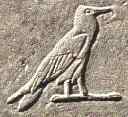 |
A | G1 | Tomb of Ti [ Dyn. V ] Saqqara |
NatG 44 |
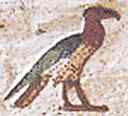 |
A | G1 | Tomb of Merenptah Siptah [ Dyn. XIX ] Valley of the Kings |
Guid 44 |
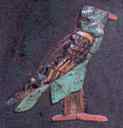 |
A | G1 | Internal coffin of Petosiri [ Ptolemaic age ] Tuna el-Gebel |
NatG 146 |
 M M |
j | M17 | White chapel of Sesostri I [ Dyn. XII ] Karnak |
Schu 136 |
 M M |
j | M17 | Coffin of Sepi [ Dyn. XII ] Deir el-Bersha |
Schu 129 |
 M M |
j | M17 | Tutankhamon's internal organs coffin [ Dyn. XVIII ] Valley of the Kings |
Schu 238 |
 |
j | M17 | Tomb of Merenptah Siptah [ Dyn. XIX ] Valley of the Kings |
Guid 44 |
 |
y | M17a | Tomb of Merenptah Siptah [ Dyn. XIX ] Valley of the Kings |
Guid 44 |
 M M |
a | D36 | Coffin of Sepi [ Dyn. XII ] Deir el-Bersha |
Schu 129 |
 |
a | D36 | Tomb of Ramesse I [ Dyn. XIX ] Valley of the Kings |
Schu 223 |
 M M |
a | D36 | Tomb of Nefertari [ Dyn. XIX ] Valley of the Queens |
Schu 246 |
| D36 - Fischer: «The Old Kingdom form shows the full breadth of the palm. Later the palm tended to be slightly cupped as in Gardiner's version. Even in the New Kingdom all the fingers are clearly distinguished in the most detailed examples (e.g. Qen Amūn, pl. 13), but this is also true of signs such as D39. And the most detailed New Kingdom examples often show the hand as in the Old Kingdom (e.g. Ramose, pl. 42).» | ||||
 M M |
w | G43 | Funerary temple of Mentuhotep II [ Dyn. XI ] Deir el-Bahri |
Schu 110 |
 |
w | G43 | Tutankhamon's golden mask [ Dyn. XVIII ] Valley of the Kings |
Schu 235 |
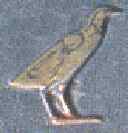 |
w | G43 | Tomb of Haremhab [ Dyn. XVIII ] Valley of the Kings |
Schu 2 |
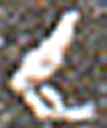 |
w | G43 | Rosetta stone [ Ptolemaic age ] Rosetta |
Schu 342 |
 |
w | G43 | Tomb of Merenptah Siptah [ Dyn. XIX ] Valley of the Kings |
Guid 44 |
 M M |
b | D58 | Temple of Montu [ Dyn. XII ] Medamud |
Schu 138 |
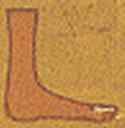 M M |
b | D58 | Coffin of Sepi [ Dyn. XII ] Deir el-Bersha |
Schu 129 |
 |
p | Q3 | Tomb of Ptahhotep [ Dyn. V ] Saqqara |
NatG 61 |
 |
p | Q3 | False door of Nakht's tomb [ Dyn. XVII ] West Thebes |
Schu 253 |
 |
p | Q3 | Red chapel of Hatshepsut [ Dyn. XVIII ] Karnak - Temple of Amon |
Schu 450 |
 |
p | Q3 | Tomb of Merenptah Siptah [ Dyn. XIX ] Valley of the Kings |
Guid 44 |
| Q3 - Fischer: «The height is normally greater than the width. Old Kingdom examples often show the detail of matting […]» | ||||
 M M |
f | I9 | Temple of Thutmosi III [ Dyn. XVIII ] Deir el-Bahri |
Schu 434 |
 |
f | I9 | Internal coffin of Petosiri [ Ptolemaic age ] Tuna el-Gebel |
NatG 146 |
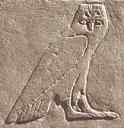 |
m | G17 | Tomb of Ptahhotep [ Dyn. V ] Saqqara |
NatG 61 |
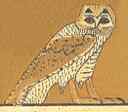 M M |
m | G17 | Coffin of Sepi [ Dyn. XII ] Deir el-Bersha |
Schu 129 |
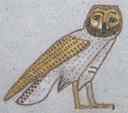 |
m | G17 | Tomb of Nefertari [ Dyn. XIX ] Valley of the Queens |
Schu 246 |
 |
n | N35 | Shrine of Sesostri I [ Dyn. XII ] Karnak |
NatG Cover |
 |
n | N35 | Tile inlaid of Ramesse II [ Dyn. XIX ] |
Writ 105 |
 |
n | N35 | Tomb of Merenptah Siptah [ Dyn. XIX ] Valley of the Kings |
Guid 44 |
| N35 - Fischer: «The number of angular ripples is variable, but the two ends always slant downward. These terminal strokes may be a little longer than the others.» | ||||
 |
r | D21 | Relief of Snefru [ Dyn. IV ] Sinai |
Schu 40 |
 |
r | D21 | Tutankhamon's golden mask [ Dyn. XVIII ] Valley of the Kings |
Schu 235 |
 |
r | D21 | Internal coffin of Petosiri [ Ptolemaic age ] Tuna el-Gebel |
NatG 146 |
| D21 - Fischer: «When carefully executed, this sign often shows a pronounced narrowing at the corners […] and the top is more curved than the bottom […]» | ||||
 |
h | O4 | Tomb of Ramesse I [ Dyn. XIX ] Valley of the Kings |
Schu 223 |
 |
H | V28 | Shrine of Sesostri I [ Dyn. XII ] Karnak |
NatG Cover |
 |
H | V28 | Relief of Sesostri I [ Dyn. XII ] Copto |
Schu 327 |
 |
H | V28 | Tomb of Merenptah Siptah [ Dyn. XIX ] Valley of the Kings |
Guid 44 |
 |
H | V28 | Tomb of Nefertari [ Dyn. XIX ] Valley of the Queens |
Nefe 54 |
 |
x | Aa1 | Coffin of Sepi [ Dyn. XII ] Deir el-Bersha |
Schu 129 |
 |
x | Aa1 | Tomb of Merenptah Siptah [ Dyn. XIX ] Valley of the Kings |
Guid 44 |
 |
X | F32 | Shrine of Sesostri I [ Dyn. XII ] Karnak |
NatG Cover |
 |
z | O34 | Back of a chair of Tutankhamon's [ Dyn. XVIII ] Valley of the Kings |
NatG 116 |
 |
z | O34 | Tomb of Ramesse I [ Dyn. XIX ] Valley of the Kings |
Schu 223 |
 |
s | S29 | Tomb of Ramesse I [ Dyn. XIX ] Valley of the Kings |
Schu 223 |
 M M |
s | S29 | Tomb of Kha-em-waset [ Dyn. XIX ] Valley of the Queens |
Nefe 50 |
 |
s | S29 | Internal coffin of Petosiri [ Ptolemaic age ] Tuna el-Gebel |
NatG 146 |
 |
S | N37 | Temple of Montu [ Dyn. XII ] Medamud |
Schu 138 |
 |
S | N37 | Tutankhamon's golden mask [ Dyn. XVIII ] Valley of the Kings |
Schu 235 |
 M M |
q |
N29 | Tutankhamon's internal organs coffin [ Dyn. XVIII ] Valley of the Kings |
Schu 238 |
 |
q |
N29 | Tomb of Merenptah Siptah [ Dyn. XIX ] Valley of the Kings |
Guid 44 |
 M M |
k | V31 | White chapel of Sesostri I [ Dyn. XII ] Karnak |
Schu 136 |
 |
k | V31 | Tutankhamon's golden mask [ Dyn. XVIII ] Valley of the Kings |
Schu 235 |
 |
g | W11 | Lintel of Sesostris III's Sed building [ Dyn. XII ] Medamun |
Schu 452 |
 |
g | W11 | Temple of Thutmosi III [ Dyn. XVIII ] Deir el-Bahri |
Schu 434 |
 |
t | X1 | Coffin of Sepi [ Dyn. XII ] Deir el-Bersha |
Schu 129 |
 |
t | X1 | Tomb of Nefertari [ Dyn. XIX ] Valley of the Queens |
Schu 246 |

| T | V13 | Funerary stela [ Dyn. II ] Saqqara |
Schu 39 |
 M M |
T | V13 | Tomb of Ptahhotep [ Dyn. V ] Saqqara |
NatG 61 |

| T | V13 | Tomb of Merenptah Siptah [ Dyn. XIX ] Valley of the Kings |
Guid 44 |

| d | D46 | Funerary stela [ Dyn. II ] Saqqara |
Schu 39 |

| d | D46 | Tomb of Merenptah Siptah [ Dyn. XIX ] Valley of the Kings |
Guid 44 |
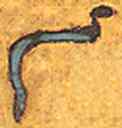 M M |
D | I10 | Tutankhamon's internal organs coffin [ Dyn. XVIII ] Valley of the Kings |
Schu 238 |
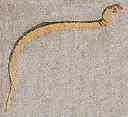 |
D | I10 | Tomb of Ramesse I [ Dyn. XIX ] Valley of the Kings |
Schu 223 |
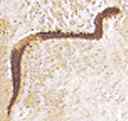 |
D | I10 | Tomb of Merenptah Siptah [ Dyn. XIX ] Valley of the Kings |
Guid 44 |
|
A few hieroglyphic signs that became monoliteral in later times and main variant forms of monoliteral signs |
||||
| Picture | Phonetic value |
Gardiner code |
Source | book |
 |
j | Z4 | Internal coffin of Petosiri [ Ptolemaic age ] Tuna el-Gebel |
NatG 146 |
 |
w | Z7 | Temple of Horu [ Dyn. XXXIII - Ptolemaic age ] Edfu |
Schu 326 |
 |
m | Aa13 | Tomb of Merenptah Siptah [ Dyn. XIX ] Valley of the Kings |
Guid 44 |
 |
m | Aa56 (from the extended library) |
Temple of Horu [ Dyn. XXXIII - Ptolemaic age ] Edfu |
Schu 326 |
 |
m | Aa56 | Rosetta stone [ Ptolemaic age ] Rosetta |
Schu 342 |
 |
n | S3 | Tomb of Ramesse I [ Dyn. XIX ] Valley of the Kings |
Schu 223 |
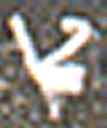 |
n | S3 | Rosetta stone [ Ptolemaic age ] Rosetta |
Schu 342 |
 |
S | N39 | Coffin of Sepi [ Dyn. XII ] Deir el-Bersha |
Schu 129 |
| Fischer [ from the notes about N37 ]: «[…] The detailed Old Kingdom example (Gardiner's N39) shows vertical ripples of water.» | ||||
 M M |
k | V31a | Coffin of Sepi [ Dyn. XII ] Deir el-Bersha |
Schu 129 |
 |
g | W12 | Tomb of Merib [ Beginning of dyn. V ] Saqqara |
Schu 80 |
 |
g | W12 | False door of Nikaura and his wife Ihat [ Dyn. V ] Saqqara |
Schu 483 |
 |
t | U33 | Tablet with the seal of the officer Ka-nakht [ Dyn. XIX ] |
Schu 352 |
 M M |
t | U33 | Tomb of Nefertari [ Dyn. XIX ] Valley of the Queens |
Nefe 168 |
 M M |
T | V14 | Mr. W. J. Bilton [ XX Century ] Messrs. Bannerman & Son, Ltd. |
Type 39 |
|
V14 - Gardiner: «Phon. T , both in hieroglyphic and hieratic, but apparently only in a few words, doubtless words in which the value T had not changed into t […]» |
||||
![]() Other signs
Other signs
| Picture | Gardiner code |
Source | book | |
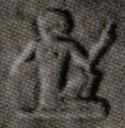 |
A1 | Tomb of Ti [ Dyn. V ] Saqqara |
Schu 382 |
|
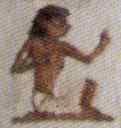 |
[ Dyn. XIX ] Valley of the Queens |
92 |
||
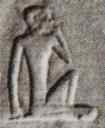 |
A2 | Tomb of Ti [ Dyn. V ] Saqqara |
Schu 383 |
|
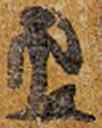 M M |
A2 | Stela of Henu with his sons [ Dyn. XII ] - |
Schu 480 |
|
A2 - Gardiner: «Note the difference from  - A1 - in the position of both arms. » - A1 - in the position of both arms. » |
||||
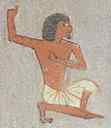 |
A8 | Tomb of Ramesse I [ Dyn. XIX ] Valley of the Kings |
Schu 223 |
|
|
Note the different position of the right foot between the signs A1-A2 and A8-A12 (read the note of Betrò related to A12). Concerning glyph A8, see also the full size image of Ramesse I, with the ba of Pe and Nekhen (Tomb of Ramesse I - [Dyn. XIX] - Valley of the Kings • Schu 223), in the hnw-posture: 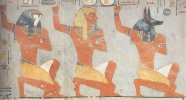 |
||||
 |
A12 | Tomb of Rahotep and Nofret [ Dyn. IV ] Meidum |
Sili 147 |
|
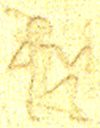 |
A12 | Tomb of Haremhab [ Dyn. XVIII ] Saqqara |
Schu 265 |
|
| A12 - Betrò: * «[…] The position of the body is tense, whippy, ready to move; it isn't the usual sitting position: the foot of the leg which is on the ground is pointing down. The weight of the body doesn't burden on it while it is distributed on all the muscles, in a tensile balance. […]» | ||||
 |
A40 | False door of Nakht's tomb [ Dyn. XVII ] West Thebes |
Schu 253 |
|
 |
A40 | Tomb of Nefertari [ Dyn. XIX ] Valley of the Queens |
Schu 246 |
|
 |
B1 | Tomb of Rahotep and Nofret [ Dyn. IV ] Meidum |
Sili 147 |
|
 |
B1 | Internal coffin of Petosiri [ Ptolemaic age ] Tuna el-Gebel |
NatG 146 |
|
 |
B7c (from the extended library) |
Tomb of Haremhab [ Dyn. XVIII ] Valley of the Kings |
Schu 2 |
|
 |
B7c |
Tomb of Nefertari [ Dyn. XIX ] Valley of the Queens |
Nefe 137 |
|
 M M |
D4 | Tomb of Haremhab [ Dyn. XVIII ] Valley of the Kings |
Schu 2 |
|
 |
D4 | Tomb of Ramesse I [ Dyn. XIX ] Valley of the Kings |
Schu 223 |
|
 |
D4 | Tomb of Nefertari [ Dyn. XIX ] Valley of the Queens |
Nefe 118 |
|
| D4 - Betrò: * «The drawing of the eye is very lengthened, like the glyph roundness had been transposed into the flat surface, obtaining a "stretched" effect. The contours and the iris are usually coloured in black, while for the corners the red is used. […]» | ||||
 M M |
D37 | Tomb of Haremhab [ Dyn. XVIII ] Valley of the Kings |
Schu 222 |
|
 |
D39 | False door of Nikaura and his wife Ihat [ Dyn. V ] Saqqara |
Schu 483 |
|
D39 - See also the hands of the full size image of Nefertari (Tomb of Nefertari - [Dyn. XIX] - Valley of the Queens • Nefe 143), offering two nw jars to the gods: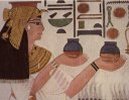 M M |
||||
 |
E34 | Funerary temple of Hatshepsut [ Dyn. XVIII ] Deir el-Bahri |
Schu 185 |
|
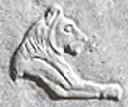 |
F4 | Funerary stela [ Dyn. II ] Saqqara |
Schu 39 |
|
 M M |
F4 | Iunu's offering table [ Dyn. IV ] Giza |
Schu 81 |
|
 |
F4 | Tutankhamon's golden mask [ Dyn. XVIII ] Valley of the Kings |
Schu 235 |
|
 |
F12 | Lintel of Sesostris III's Sed building [ Dyn. XII ] Medamun |
Schu 452 |
|
 M M |
F12 | Tile inlaid of Ramesse II [ Dyn. XIX ] |
Writ 105 |
|
 |
F31 | Back of a chair of Tutankhamon's [ Dyn. XVIII ] Valley of the Kings |
NatG 116 |
|
 |
F31 | Tomb of Ramesse I [ Dyn. XIX ] Valley of the Kings |
Schu 223 |
|
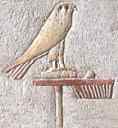 M M |
G7 | Iunu's offering table [ Dyn. IV ] Giza |
Schu 81 |
|
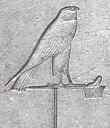 |
G7 | Lintel of Sesostris III's Sed building [ Dyn. XII ] Medamun |
Schu 452 |
|
 M M |
I6 | Standard-bearer statue of Sethi II [ Dyn. XIX ] Karnak - Temple of Amon-Re |
Schu 170 |
|
 |
N5 | Shrine of Sesostri I [ Dyn. XII ] Karnak |
NatG Cover |
|
 |
N5 | Tomb of Nefertari [ Dyn. XIX ] Valley of the Queens |
Nefe 54 |
|
 |
N17 | Tomb of Nefertari [ Dyn. XIX ] Valley of the Queens |
Nefe 54 |
|
 |
O49 | Lintel of Sesostris III's Sed building [ Dyn. XII ] Medamun |
Schu 452 |
|
 |
R8 | Internal coffin of Petosiri [ Ptolemaic age ] Tuna el-Gebel |
NatG 146 |
|
| R8 - Fischer: «The top of the pennant is slanted; the bottom, in the Old Kingdom, was usually horizontal, but sometimes also slanted as in Gardiner's version. The pennant consists of strips of cloth, wound around the pole. […]» | ||||
 |
R11 | Temple of Thutmosi III [ Dyn. XVIII ] Deir el-Bahri |
Schu 434 |
|
| R11 - Fischer: «Normally the top is quadruple, rarely triple […]» | ||||
 M M |
R14 | Tomb of Haremhab [ Dyn. XVIII ] Valley of the Kings |
Schu 2 |
|
 M M |
R19 | Tomb of Haremhab [ Dyn. XVIII ] Valley of the Kings |
Schu 2 |
|
 M M |
R19 | Lintel of Sesostris III's Sed building [ Dyn. XII ] Medamun |
Schu 452 |
|
 |
S34 | Lintel of Sesostris III's Sed building [ Dyn. XII ] Medamun |
Schu 452 |
|
 M M |
U21 | Tile inlaid of Ramesse II [ Dyn. XIX ] |
Writ 105 |
|
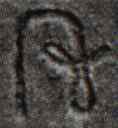 |
V31 | Tomb of Merib [ Beginning of dyn. V ] Saqqara |
Schu 80 |
|
 |
V30 | Relief of Snefru [ Dyn. IV ] Sinai |
Schu 40 |
|
 |
V30 | Tomb of Nefertari [ Dyn. XIX ] Valley of the Queens |
Nefe 54 |
|
| V30 - Betrò: * «[…] [In the Old Kingdom examples] the hieroglyphs are coloured in green or yellow, to simulate the colour of the vegetal fibres, fresh or dry, and in the inner part of the basket several horizontal lines are drawn, representing the spiral rounds of the twisted fibres. […]» | ||||
 |
W19 | Tomb of Nefertari [ Dyn. XIX ] Valley of the Queens |
Nefe 54 |
|
 |
X8 | Red chapel of Hatshepsut [ Dyn. XVIII ] Karnak - Temple of Amon |
Schu 450 |
|
 |
Y1 | Tomb of Merenptah Siptah [ Dyn. XIX ] Valley of the Kings |
Guid 44 |
|
 |
Z1 | Tomb of Merenptah Siptah [ Dyn. XIX ] Valley of the Kings |
Guid 44 |
|
